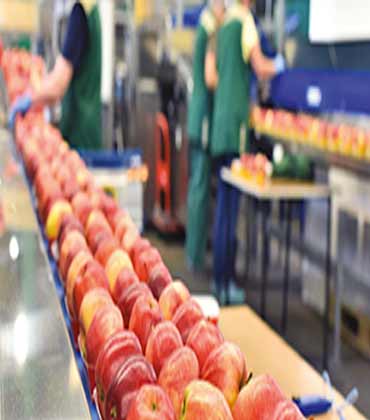THANK YOU FOR SUBSCRIBING
By Todd Jongen, Director Non-Foods Product Development and Packaging Science, US Foods
A Brief History of Carry-Out Food Packaging
By Robert Erhard, Head of Dairy, Corporate Sustainable Agricultural Development, Nestle
Transforming the Food Industry Through a Sustainable...

A Sustainable Solution to Food Waste and Quality Control in Fermented Products
Sarah Engstrom, Senior Scientist at Grande Custom Ingredients Group

 Sarah Engstrom, Senior Scientist at Grande Custom Ingredients Group
Sarah Engstrom, Senior Scientist at Grande Custom Ingredients GroupSarah Engstrom is a Sr. Scientist at Grande Custom Ingredients. She holds an M.S. and Ph.D. in food science from the University of Wisconsin. Previously, she was an R&D Manager at Kerry and a food safety microbiologist at the Food Research Institute, Oscar Mayer / Kraft Heinz, and Land OLakes.
Through this article, Sarah explores the benefits of using functional dairy powders as a sustainable alternative to fresh fermented dairy products. She discusses how these powders can help mitigate food waste, improve shelf life, and maintain product quality. By addressing temperature fluctuations and reducing reliance on perishables, dairy powders offer solutions for nutrition enhancement and efficient food production while supporting sustainability goals.
Fresh fermented dairy products like cheese, yogurt, and sour cream are dynamic biological systems with active culture populations continuing to grow or decline depending on their extrinsic environments. Temperature and humidity fluctuations can give way to the outgrowth of desirable or undesirable microorganisms, leading to direct (e.g., visual mold growth, high CFU) or indirect (e.g., acidification, gassing, packaging integrity loss) food spoilage events. Fresh uncultured products (e.g., pasteurized cream, liquid eggs, butter) are similarly susceptible to supply chain variation.
This can result in food waste at the manufacturer's level when perishables are used as ingredients in formulation or at the level of the consumer when purchased directly for home consumption. Regardless, the effect is the same—loss of brand reputation, loss of repeat purchases, and loss of available nutrients to an ever-growing and increasingly sustainability-focused population.
"Functional dairy powders provide a crucial tool for product developers, enabling them to reduce reliance on perishables, mitigate temperature-related quality defects, and decrease food waste while maintaining product integrity."
Strategies to mitigate food waste of perishables include improving cold-chain management, transitioning to frozen storage, adding conventional or natural preservatives, reducing the useable age of the ingredient or shelf-life of the end product, or partial/complete replacement of the ingredient, among other options
Dried dairy ingredients have a long history of replacing fresh ingredients to lessen volatile markets, e.g., butter, cheese, and eggs. Most dairy powders have shelf lives ranging from 12-24 months, making them attractive options for export. Sustainability benefits of dairy powders over their fluid counterparts include reducing weight, volume, and associated transportation and storage costs, potentially resulting in lower Carbon Intensity Values and more attractive inputs for Life Cycle Assessments versus perishable options.
Not all dairy powders are created equal, and selecting the correct dairy ingredient for the targeted application is essential. Replacement of high-fat dairy inputs with dairy powders can positively impact nutrition targets such as protein enrichment, reduction of sugar/sodium/fat/calories, or potential removal of an allergen from the formula (e.g., eggs). Delactosed whey permeate, reduced lactose whey, and whey or milk permeate have all been used as sodium reduction tools due to their relatively high contents of dairy minerals and other trace elements (e.g., non-protein nitrogen and organic acids) and have historically been used in replacing aged cheese and cheese powders. This can reduce the time and stringent conditions needed for aging cheeses and improve the end product's nutritional composition.
The lactose content, the sugar naturally present in milk, varies between dairy ingredients, with the lowest contents typically seen with isolates (90% protein) and micellar casein concentrates. Whether lactose is desirable depends on the end application and claims desired. Whey and milk protein isolates are used extensively in protein-fortification efforts. In baked goods, lactose cannot be fermented by baker’s yeast and is therefore available for Maillard reactions contributing to browning. Dairy ingredients, except for purified lactose (a sweetener defined under CFR 168.122), are not included in the US definition of “Added Sugars” and are thus exempt from this labeling.
Within bakery applications, other dairy powders, e.g., whey protein isolate whey protein concentrate, have been used in egg and butter replacement, respectively, and non-fat dry milk is used extensively in fresh milk replacement. Supplier partners should provide realistic replacement recommendations in specific applications, mainly when the function of a fresh ingredient is vital to the integrity of the product (e.g., egg whites in a meringue versus eggs used in cookies).
Fresh yogurt and sour cream are commonly used for texture, flavor, and mouthfeel. However, both raw materials can spoil rapidly, particularly with temperature abuse or fluctuations in quality between suppliers, causing over-acidification, syneresis, or growth of yeasts and molds. Yogurt powders carry the associated health halo of yogurt (with associated “yogurt” labeling if SOI is met) despite the absence of live and active cultures. At high replacement rates of yogurt powder for fresh yogurt, it is imperative to account for the lost lactic acid to achieve the same or better shelf-life in the final product; vinegar, lactic acid, or a clean-label antimicrobial can all be used to this effect.

Limiting reliance on perishable ingredients is a crucial challenge for today’s product developers. Functional dairy powders are a tool in the toolbox to reduce or remove them to lessen temperature fluctuation-associated quality defects, free up refrigerated storage space, and decrease food waste. With all dried dairy ingredients, it is recommended to work with the supplier(s) to determine whether processing and formulation changes (e.g., increased hydration time before heat treatment, addition of starch/solids/water, altered order of addition) are needed moving from perishable ingredient to dairy powder, and to give recommendation on realistic use rates and replacement targets.
Read Also















